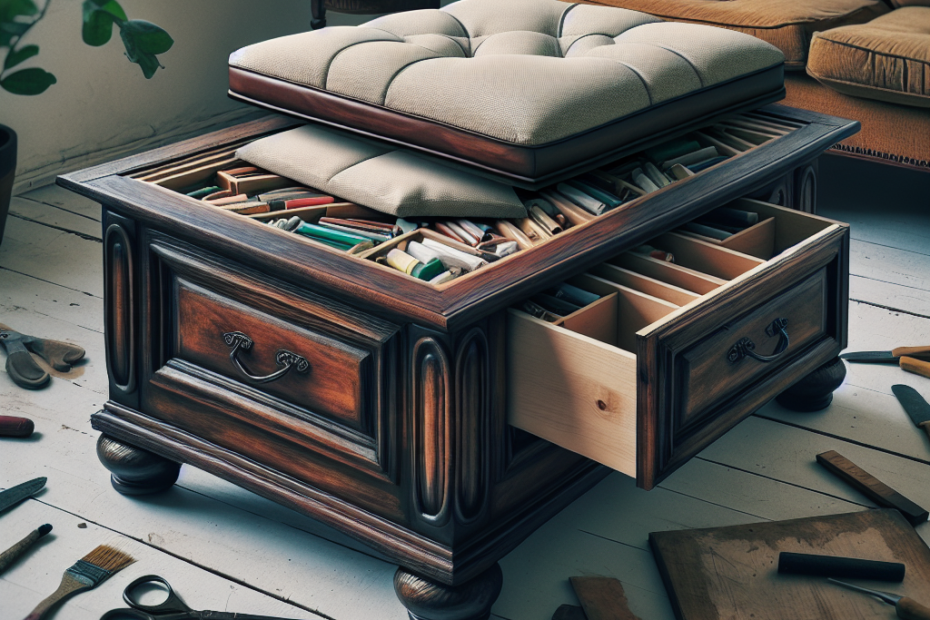Many people are seeking creative ways to enhance their living spaces without spending a fortune. One popular trend is upcycling, which involves transforming old or unused items into something new and valuable. An excellent project for this is turning an old coffee table into a chic ottoman with storage. This DIY project not only modernizes a living room but also adds functionality and charm. By focusing on the keyword “Upcycled Coffee Table Ottoman,” homeowners can discover how to give their furniture a second life and reduce waste.
Why Upcycle a Coffee Table?
Upcycling is economically and environmentally beneficial. With around 9.8 million tons of furniture waste ending up in landfills each year in the U.S alone (source: EPA), giving an old coffee table a new purpose helps reduce this statistic and promotes sustainability. Not to mention, a custom-made ottoman can add character to a room, serving as a conversation starter.
Choose the Right Table
The first step in transforming a coffee table is selecting the right one. It must be sturdy and in good condition, as the foundation of a chic ottoman depends on the quality of the table. Consider a table with a flat top and a solid frame, as these materials are easier to work with during the upcycling process.
Materials and Tools Needed
To successfully upcycle an old coffee table into a stylish ottoman, they will require several tools and materials. Here’s a basic list:
- Foam padding
- Fabric or upholstery
- Batting
- Staple gun
- Screws and a screwdriver
- Paint or wood stain (optional)
- New legs (optional, for added height)
Step-by-Step Transformation
Here is a simple guide to follow when turning a coffee table into an ottoman:
- Prepare the Table: Clean the table thoroughly. If necessary, sand any rough spots and apply a fresh coat of paint or stain for a new look.
- Add Foam Padding: Measure and cut foam padding to fit the tabletop. Use adhesive spray to secure the foam, ensuring it’s centered and even across the surface.
- Wrap with Batting: Lay batting over the foam, allowing extra to wrap around the edges. Staple the batting to the underside of the table, pulling it taut to create a smooth surface.
- Upholster with Fabric: Cut fabric to cover the batting and foam, leaving enough to staple underneath the table. Start from the center of each side, pulling tight as you go to avoid wrinkles.
- Attach New Legs: If desired, replace existing legs with stylish new ones to enhance the ottoman’s appearance. Ensure they are securely screwed into place.
- Add Storage: If the table design permits, add storage by incorporating baskets or creating a hollow space inside.
Styling and Finishing Touches
Choosing the right fabric can transform a simple ottoman into a bold statement piece or a subtle accent. They can opt for vibrant patterns or neutral tones, depending on their existing décor. Adding decorative elements like buttons or tufts can further enhance the look.
| Step | Description |
|---|---|
| Prepare the Table | Clean, sand, and paint or stain the table. |
| Add Foam Padding | Secure foam with adhesive spray. |
| Wrap with Batting | Staple batting over foam, pull taut. |
| Upholster with Fabric | Cover batting with selected fabric. |
| Attach New Legs | Optional: screw in stylish new legs. |
| Add Storage | Incorporate baskets or create hollow space. |
Key Takeaways
- Upcycling is a sustainable and cost-effective solution to reduce furniture waste.
- An old coffee table can be transformed into a chic and functional ottoman with storage.
- Careful selection of materials and tools is crucial for successful upcycling.
- Styling and fabric choice enhance the visual appeal of the ottoman.
Frequently Asked Questions
1. Why is upcycling beneficial?
Upcycling helps reduce waste, promotes sustainability, and saves money by transforming old items into functional pieces.
2. Can any coffee table be converted into an ottoman?
While most tables can be upcycled, it’s best to choose one that’s sturdy and in good condition.
3. Which fabric works best for an ottoman?
Durable fabrics like cotton, linen, or synthetic blends are ideal for upholstery projects.
4. Do they need special tools to complete this project?
Basic tools like a staple gun, screwdriver, and optionally, a paintbrush are typically sufficient.
5. How can storage be added to the ottoman?
They can add baskets underneath or construct a compartment within the table body for storage.
